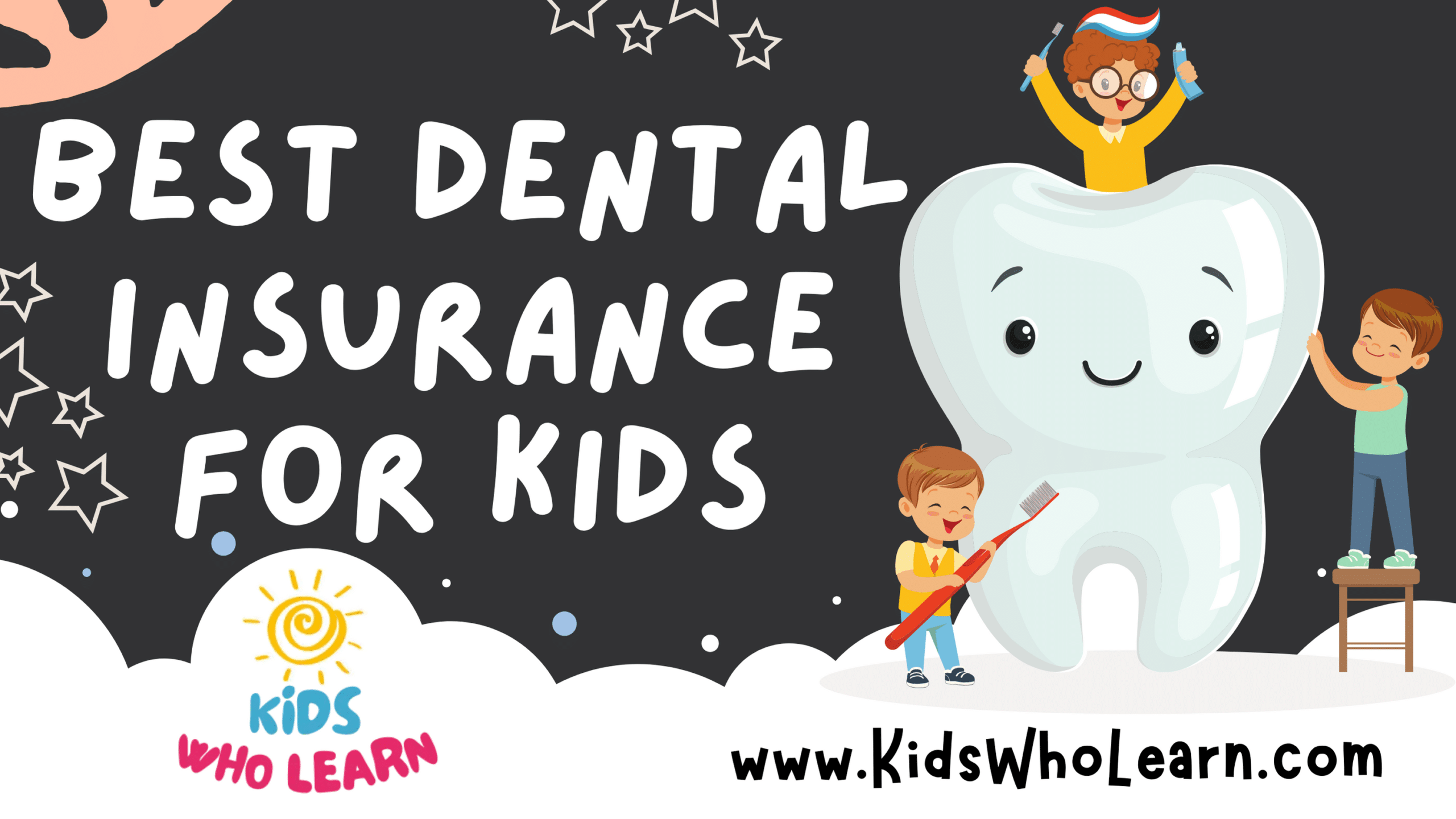Choosing the best dental insurance for your children is a critical step towards ensuring their oral health. As parents, we’re often concerned about providing our kids the best possible care, and this includes dental health, which is a vital component of their overall well-being. Ensuring that your child has access to quality dental care can prevent a multitude of dental issues and contribute to their general health.
Understanding the various dental plans and knowing what to look for can be overwhelming. But it’s our job to evaluate which dental insurance will provide the most comprehensive coverage for our kids. From regular check-ups and cleanings to orthodontic treatments, the right dental insurance can help mitigate the out-of-pocket expenses. Identifying policies that include pediatric coverage and align with the needs of your children could offer peace of mind when it comes to managing dental expenses.
When exploring dental insurance options for kids, it’s also important to consider the network of providers. Selecting a plan with a broad network of pediatric dentists could mean easier access to care and potentially better rates. Moreover, understanding any special considerations that apply to children’s oral health and the additional benefits that certain plans may offer can be highly beneficial. Overall, a comprehensive approach to choosing dental insurance will ensure that our children get the care they need without unnecessary costs.
Key Takeaways
- Adequate dental insurance is integral to children’s oral health.
- Evaluating dental plans for comprehensive pediatric coverage is essential.
- Choosing an insurance with a wide provider network aids in easy access to care.
Understanding Dental Insurance for Kids
We understand that navigating dental insurance for kids can be complex. It’s vital to know what such insurance entails, the specific features to look for, and the impact of the Affordable Care Act on pediatric dental coverage.
What Constitutes Dental Insurance for Kids
Dental insurance for kids is specifically designed to provide coverage for oral health needs unique to children. This type of insurance plan typically covers a range of services including preventive care like cleanings and fluoride treatments, basic procedures such as fillings, and sometimes more advanced treatments. Coverage details can vary, so it’s important to review what each plan offers.
Key Features of Pediatric Dental Plans
When exploring options, keep an eye on these key features:
- Preventive Care: Most plans cover 100% of preventive care costs, including check-ups.
- Cost-Sharing: Look at the cost-sharing aspects such as deductibles, copayments, and coinsurance.
- Annual Maximums: Some plans cap the amount they will pay in a year.
- Network: A plan’s network of dentists can affect availability and costs.
Essential Health Benefits and the ACA
Under the Affordable Care Act, pediatric dental coverage is considered an Essential Health Benefit (EHB). This means that any insurance plan sold on the Health Insurance Marketplace must offer dental coverage for children. As we evaluate plans, note that they might be standalone plans or may be included as part of a health plan. However, unlike other EHBs, dental coverage for children is not a mandatory purchase under the ACA.
Evaluating Dental Plans for Children
When examining dental plans for our children, it is crucial for us to consider the extent of coverage provided, including the specifics of what is and isn’t covered, the limits set on the coverage, and the inclusion of essential services like orthodontics and preventive care.
Coverage Details and Limits
Coverage Details: We must first scrutinize the specifics of what the dental plan covers. It’s imperative to identify whether the plan offers comprehensive coverage that encompasses diagnostic, preventive, and emergency services. Typically, good dental plans for kids include:
- Routine check-ups and cleanings: Covered typically twice a year.
- X-rays: Essential diagnostic tools covered regularly.
- Fillings and extractions: Basic restorative work should be part of the coverage.
Coverage Limits: Every plan imposes certain monetary caps on coverage, which we refer to as coverage limits. These limits can be annual or lifetime, and understanding them helps us avoid extraneous out-of-pocket expenses. We should look out for:
- Annual maximums: The highest amount the insurance will pay in a year.
- Deductibles: The upfront cost we pay before insurance takes effect.
- Co-pays: A fixed fee for a covered service, payable at the time of the visit.
Inclusion of Orthodontics and Preventive Care
Orthodontics: Given that many children may need braces or other orthodontic work, checking if these services are included in the plan is essential. When they are covered, we should pay attention to:
- Age limits: Some plans have age restrictions for orthodontic coverage.
- Waiting periods: The time we must wait before being eligible for orthodontic benefits.
Preventive Care: Preventive services are key in maintaining a child’s oral health. A robust plan should cover the full scope of preventive care without imposing steep out-of-pocket costs. Included services often entail:
- Sealants: Plastic coatings applied to the chewing surfaces of back teeth to prevent decay.
- Fluoride treatments: Help to strengthen enamel and resist cavities.
By considering these aspects carefully, we can ensure that the dental plan we choose provides the right benefits to meet our children’s specific dental health needs without unexpected expenses.
Cost Considerations
When choosing the best dental insurance for kids, it’s crucial to understand the financial components that affect coverage. These include monthly premiums, deductibles, copays, coinsurance, and overall out-of-pocket costs—all of which determine the affordability of a plan.
Premiums, Deductibles, and Copays
Monthly Premiums are the regular payments we make to keep our dental insurance active. For a child’s plan, premiums may vary based on coverage levels and whether the plan is public or private. Deductibles are the amounts we must pay out-of-pocket before insurance kicks in. Lower deductibles can mean higher monthly premiums, but can be beneficial if frequent dental care is anticipated. Copays are fixed fees for certain services; for example, $20 for a check-up, regardless of the total cost of the visit.
- Monthly Premium: $30-$50 (on average for child’s plan)
- Deductible: $50-$150 (annually, per child)
- Copay: $10-$40 (per visit, depending on the service)
Out-of-Pocket Costs and Affordability
Out-of-Pocket Costs are expenses for services that aren’t fully covered by insurance. These costs can accumulate from copays, non-covered services, and costs above policy limits. Tracking these expenses is essential to gauge the overall affordability of a plan. A plan with low premiums might seem affordable, but high out-of-pocket costs can make it less so. We recommend comparing annual out-of-pocket maximums when assessing plans.
- Out-of-Pocket Maximum: $350-$700 (annually, per child)
Understanding Coinsurance and Cost Sharing
Coinsurance is the percentage of costs we share with the insurance provider once the deductible is met. For instance, the plan might cover 80% of restorative services, leaving us responsible for the remaining 20%. It’s an important factor to consider, as it directly affects out-of-pocket expenses after the deductible. Cost Sharing refers to the combined financial responsibility of premiums, deductibles, copays, and coinsurance. Understanding this concept helps us make informed decisions about the balance between monthly costs and potential service charges throughout the year.
- Coinsurance: Typically 20%-40% (post-deductible)
Preferred Provider Networks
When selecting dental insurance for children, understanding the intricacies of Preferred Provider Networks (PPNs) is critical. We must consider the network size, the availability of pediatric dentists, and the potential cost savings.
Benefits of In-Network Providers
Provider Network Size: Insurance with a large provider network often means more choices and easier access to preferred pediatric dentists. Within this network, we can find specialists capable of catering to our children’s specific dental needs. It is crucial to verify that the insurance plan’s network is expansive enough to provide an array of options close to home.
Cost Savings: By choosing an in-network provider, we can take advantage of negotiated discounts that reduce out-of-pocket expenses. Most dental insurance plans have agreements with their network dentists to charge predetermined rates, which are typically lower than their standard fees.
Quality of Care: In-network providers are generally required to meet specific standards set by the insurance company, ensuring that our children receive quality dental care. While all dentists must adhere to general dental board regulations, those within a network might undergo additional scrutiny, providing an extra layer of confidence in the care provided.
Simplified Billing Process: Working with in-network providers usually streamlines the billing process. Since the insurance provider and the dentist have an established relationship, claim forms and payment processes tend to be more straightforward, leading to fewer billing headaches for us.
Predictability: When we use in-network dentists, the costs incurred are more predictable due to the pre-negotiated rates. This allows us to better plan our dental expenses and avoid unexpected bills.
In summary, leveraging an insurance plan’s Preferred Provider Network can lead to cost savings, ensure quality care for our children, and provide access to a more comprehensive selection of dentists. It is a vital component in our decision-making process when choosing the best dental insurance for our kids.
The Importance of Pediatric Dental Coverage
We understand that dental health is pivotal for children, not only for their current well-being but also to set the stage for healthy teeth and gums as they grow. Ensuring they have proper pediatric dental coverage is crucial for maintaining their oral health through preventive care and timely treatments.
Preventing Cavities and Oral Diseases
Cavities, also known as dental caries, are one of the most common oral health issues among children. We can significantly reduce the risk of cavities by securing dental coverage that includes routine check-ups and fluoride treatments. Fluoride is a natural mineral that strengthens enamel and makes teeth more resistant to decay.
- Routine Check-ups: Typically covered twice a year, these appointments allow pediatric dentists to detect early signs of decay and administer appropriate treatments.
- Fluoride Treatments: Applied regularly during dental visits, fluoride helps in the prevention of dental caries.
Gum disease, while less common in children than adults, can still occur. Regular cleanings and exams covered by dental insurance play a key role in diagnosing and treating gum disease before it becomes severe.
Managing Dental Emergencies and Orthodontic Needs
We recognize that dental emergencies can happen without warning. Dental insurance that covers emergencies can alleviate the financial stress and ensure swift care.
- Emergency Visits: Coverage often includes care for traumatic injuries or urgent problems like a severe toothache.
Orthodontic coverage is also a significant component of pediatric dental insurance. Many children require braces or other orthodontic devices to correct misaligned teeth and jaws, which are crucial for proper function and appearance.
- Orthodontic Assessments and Treatments: Coverage may partially or fully include the cost of braces or other corrective devices. It’s important to read the specific terms, as limitations or waiting periods may apply.
In conclusion, pediatric dental coverage is instrumental in preventing and managing oral health issues. Through regular check-ups and fluoride treatments, we can combat decay and gum disease. Additionally, having coverage for dental emergencies and orthodontic needs ensures comprehensive care for children’s unique dental health requirements.
Choosing the Right Dental Insurance Company
When selecting a dental insurance plan for children, it’s crucial to weigh the benefits offered by reputable providers. We’ll guide you through a comparison of top providers to ensure you secure the best coverage for your child’s dental care needs.
Comparing Top Dental Insurance Providers
Delta Dental: As one of the largest providers, Delta Dental offers various plans tailored to children’s dental care. We consider their coverage options comprehensive, including preventive care and orthodontic benefits.
- Network Size: Expansive network of dentists
Humana: Humana is known for versatile dental insurance options and offers plans that emphasize preventive services. This can be especially beneficial for ensuring children get regular check-ups.
- Plan Options: Includes both PPO and prepaid plans
- Benefits: Focused on prevention and maintenance
MetLife: MetLife’s dental insurance provides a broad range of services, including orthodontics, which is often a consideration for many parents. Also, they often feature plans with high annual benefit maximums.
- Coverage: Extensive services including orthodontic care
- Annual Maximums: Typically higher, offering more coverage
UnitedHealthcare: UnitedHealthcare has a strong presence in the market and offers dental plans that are user-friendly with easy online management. They balance affordability with a good selection of covered services.
- User Experience: Simplified plan management online
- Affordability: Competitive pricing with reliable coverage
Guardian Dental: Guardian Dental grants access to a vast network and provides dental insurance plans that are known for swift claim processing and customer service.
- Network: Large network of dental providers
- Customer Service: Known for prompt and helpful support
Spirit Dental: Spirit Dental is unique for offering no waiting periods on any services, which is ideal for immediate dental care. They also provide options that include orthodontics and implants.
- Waiting Period: None, even for major services
- Orthodontics Coverage: Available in certain plans
To make an informed decision, we need to carefully review the specifics of each plan, such as inclusions, exclusions, network size, pricing, and customer reviews. It’s also vital to consider the individual dental care needs of our children when choosing the right provider.
Special Considerations
When selecting the best dental insurance for children, it’s essential to be aware of specifics like waiting periods and policy limits. We’ll guide you through the intricacies of dealing with these elements to ensure your family is fully covered.
Handling Waiting Periods and Annual Maximums
Many dental insurance plans have waiting periods that can range from a few months to a full year before certain services are covered. It’s crucial for us to check the specifics of our plan to understand this timeframe. Similarly, annual maximums cap the amount an insurance company will pay within a year, leaving us responsible for any costs beyond that. We should compare:
- Waiting Periods
| Service Type | Typical Waiting Period |
|---|---|
| Preventive | No waiting period |
| Basic Restorative | 3-6 months |
| Major Services | 6-12 months |
- Annual Maximums
| Coverage | Average Annual Maximum |
|---|---|
| Basic Plan | $1,000 – $1,500 |
| Enhanced Plan | $2,000 – $3,000 |
Coverage for Major Dental Work
Insurance for major dental work like orthodontics is paramount, especially for kids. Such procedures can be expensive, so it’s imperative to verify if our plan categorizes braces and similar work as major services and what percentage is covered. A thorough review ensures:
- Orthodontics Coverage is often separate from other services.
- Co-Payments and Coinsurance details that affect out-of-pocket costs.
Family Plans and Dependent Coverage
Family dental insurance plans can offer a sensible way to secure coverage for the whole family. The main advantage of family plans is that they often provide more comprehensive coverage for dependents. We must discern:
- The age limit for family coverage, as it varies by plan.
- Whether the plan allows for the addition of new dependents without hassles.
| Feature | Advantage |
|---|---|
| Single annual maximum | Easier management of family dental expenses |
| Combined deductibles | Potential cost savings across family members |
Additional Benefits and Services
When seeking dental insurance for children, it’s important to understand the specifics of coverage for routine procedures. These services are essential for maintaining good oral health and preventing future dental issues.
Coverage for Cleanings, Exams, and Basic Care
Cleanings and Exams:
Regular dental cleanings and exams are vital for children’s dental health. Our insurance plans typically cover:
- Cleanings: At least two cleanings per year.
- Exams: Annual or semi-annual exams, to monitor oral health.
X-Rays:
Dental X-rays help in diagnosing issues that are not visible during a regular exam. Coverage often includes:
- Bitewing X-rays: Usually covered once or twice a year.
- Panoramic X-rays: Often covered every few years, as necessary.
Basic Care:
Basic dental procedures such as fillings, sealants, and sometimes even fluoride treatments are typically covered. However, the extent of coverage can vary based on the specific plan. Commonly, insurance provides:
- Fillings: Coverage for various types of fillings, with some policies having a limit on the number per year.
- Sealants: Often covered for molars and premolars on a limited basis.
It’s important to review the details of any plan to understand the full extent and limitations of the coverage for these essential services.
Frequently Asked Questions
Choosing the best dental insurance requires understanding the specifics of what each plan offers, especially when it comes to children’s dental needs like major work, braces, and newborn coverage. Below we answer some common questions to help you find the right coverage for your child.
How do I choose the best dental insurance for major dental work for my child?
When evaluating dental insurance for major dental work, ensure the plan covers a significant portion of procedures such as root canals, crowns, and oral surgeries that children may require. Look for low deductibles, reasonable annual maximums, and a wide network of pediatric dentists.
What pediatric dental coverage options are available through Blue Cross Blue Shield?
Blue Cross Blue Shield provides various options for pediatric dental coverage, which often include preventative care like checkups and cleanings, and cover essential procedures. Benefits can vary by plan and state, so we recommend reviewing their specific plan details for pediatric coverage.
Which dental insurance plans are considered the most comprehensive for child braces?
Insurance plans that offer orthodontic benefits, including Invisalign and traditional braces, are regarded as comprehensive for child braces. Search for plans that list orthodontics in the coverage and check the lifetime maximum benefits for orthodontic work.
How does Guardian dental insurance cater to the needs of children’s dental care?
Guardian dental insurance generally includes coverage for preventive care, fillings, and orthodontics, making it attuned to the needs of children’s dental care. Guardian networks also often feature pediatric dental specialists.
What factors should be considered when looking for newborn dental insurance?
For newborn dental insurance, consider plans that start covering dental benefits from an early age. Emphasize preventive care and check if the plan offers coverage for potential early childhood dental issues.
What are the typical inclusions and exclusions of Anthem dental insurance for pediatric dentistry?
Anthem dental insurance often includes routine cleanings, exams, and X-rays, and may provide coverage for fillings and emergency care in pediatric dentistry. It’s important to review the fine print for any specific exclusions, such as cosmetic procedures.










